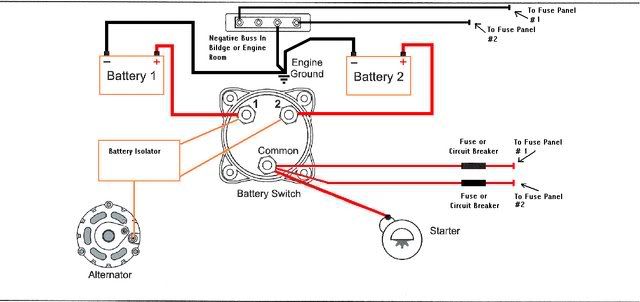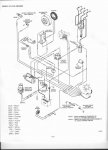Have a mercruiser 3.7LX Alpha one on my 1990 Regal Sebring. Installed a new stereo to listen to while sitting in the cove and quickly realized my need for a second battery. =(
I've done a lot of research on how to hook everything up - I have two batteries, a switch, and an isolator. At first everything seemed fairly straight forward - connect the alternator to the isolator - the 1 and 2 posts of the isolator to the switch - those posts to the battery and the common of the switch back to the motor.
Seems fairly straight forward. HOWEVER - I crawl into my engine and I get confused. Currently I've got a red cable running straight from my cranking battery to the starter. From there - there is also an orange wire (that normally I would assume runs to the alternator) that runs to a voltage regulator. There is also a yel/red wire connected to the starter that runs to the slave solenoid, and another red wire that runs to a circuit breaker that runs a red/pur wire back to the voltage regulator.
Now, if I'm correct, I think I should take the orange wire to the isolator, and leave the yellow/red wire on the starter. ANother red wire should go from the starter off to the switch, but what do I do with that last red wire that runs to the circuit breaker and back to the voltage regulator???
Or is the voltage regulator a type of isolator and my isolator is not needed?
I've been reading everywhere - but can't seem to find out what to do. Any help that you guys could provide, would be greatly appreciated!!
I've done a lot of research on how to hook everything up - I have two batteries, a switch, and an isolator. At first everything seemed fairly straight forward - connect the alternator to the isolator - the 1 and 2 posts of the isolator to the switch - those posts to the battery and the common of the switch back to the motor.
Seems fairly straight forward. HOWEVER - I crawl into my engine and I get confused. Currently I've got a red cable running straight from my cranking battery to the starter. From there - there is also an orange wire (that normally I would assume runs to the alternator) that runs to a voltage regulator. There is also a yel/red wire connected to the starter that runs to the slave solenoid, and another red wire that runs to a circuit breaker that runs a red/pur wire back to the voltage regulator.
Now, if I'm correct, I think I should take the orange wire to the isolator, and leave the yellow/red wire on the starter. ANother red wire should go from the starter off to the switch, but what do I do with that last red wire that runs to the circuit breaker and back to the voltage regulator???
Or is the voltage regulator a type of isolator and my isolator is not needed?
I've been reading everywhere - but can't seem to find out what to do. Any help that you guys could provide, would be greatly appreciated!!






















